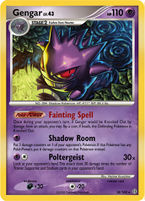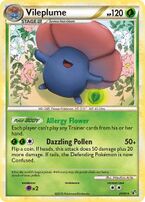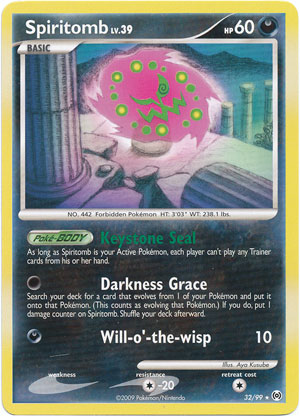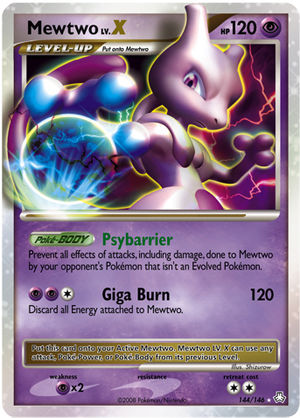VileGar (TCG)
| VileGar | ||||||||||
|---|---|---|---|---|---|---|---|---|---|---|
| ||||||||||
VileGar is a popular deck archetype in competitive Pokémon Trading Card Game play. The deck centers around the synergy between Stormfront Gengar and Undaunted Vileplume. Spiritomb from Arceus is used to set up, Gengar is used to attack, and Vileplume is used to keep a continuous Trainer lock on the opponent. The deck has placed well in numerous Battle Roads at the beginning of the 2010-2011 season.
Strategy
Spiritomb is the deck's ideal opening Pokémon. It prevents the opponent from playing Trainer cards with its Keystone Seal Poké-Body, while at the same time evolving the VileGar player's benched Pokémon with Darkness Grace. If the deck opens with Spiritomb and gets Vileplume out quickly, the opponent can often be prevented from playing Trainer cards through the entirety of the game. Gastly also provides a good start when Spiritomb is not available, since it can also prevent the opponent from playing Trainer cards with its Pitch Dark attack. Essentially, VileGar's modus operandi during the earlygame is to slow down the opponent while setting up through a strong Supporter engine.
The deck utilizes a combination of drawing effects, such as Uxie, Unown R, and Professor Oak's New Theory, and searching effects, such as Bebe's Search and Pokémon Collector, to get out at least one Vileplume and Gengar as soon as possible. Vileplume keeps the Trainer lock on with its Allergy Flower Poké-Body. Gengar is the deck's main attacker. Its synergy with Vileplume stems from its Poltergeist attack, which, for ![]()
![]() , does 30 damage for each Trainer, Supporter, and Stadium card in the opponent's hand. Since Allergy Flower prevents the opponent from playing Trainers, there will often be a large amount of them built up in his or her hand, allowing Poltergeist to do a large amount of damage.
, does 30 damage for each Trainer, Supporter, and Stadium card in the opponent's hand. Since Allergy Flower prevents the opponent from playing Trainers, there will often be a large amount of them built up in his or her hand, allowing Poltergeist to do a large amount of damage.
Key Cards
- Gengar - Gengar is the deck's main attacker. Since Spiritomb and Vileplume cause the opponent to accumulate Trainer cards in his or her hand, Gengar's Poltergeist attack can do a tremendous amount of damage. Additionally, Gengar is often able to take easy prizes off the opponent's bench with Shadow Room which, for
 , places six damage counters on an opponent's Pokémon that has any Poké-Powers (or three damage counters on a Pokémon without Poké-Powers). Gengar also possesses the Fainting Spell Poké-Power, which allows a 50% chance that an opponent's Pokémon knocking out Gengar will be knocked out as well.
, places six damage counters on an opponent's Pokémon that has any Poké-Powers (or three damage counters on a Pokémon without Poké-Powers). Gengar also possesses the Fainting Spell Poké-Power, which allows a 50% chance that an opponent's Pokémon knocking out Gengar will be knocked out as well. - Vileplume - Vileplume slows the opponent by preventing him or her from playing Trainer cards. It also allows for Gengar to do more damage with Poltergeist by forcing the opponent to build up Trainer cards in his or her hand.
- Spiritomb - Spiritomb is the deck's ideal start, and, by preventing the opponent from playing Trainer cards with its Keystone Seal Poké-Body, provides the VileGar player with ample time to set up. For no energy cost, Spiritomb can also use Darkness Grace to evolve one of the player's benched Pokémon. In a deck running two large evolution lines, this is a very beneficial effect. It allows the VileGar player to avoid devoting resources to getting a Vileplume up and running that could instead be devoted to Gengar.
- Pokémon Collector - Pokémon Collector is critical early in the game, since it allows the VileGar player to immediately search out several Basic Pokémon with which to either assist with set up or begin evolving immediately. Often, a bad start will be rectified through Pokémon Collector by searching out Spiritomb, Unown Q, and either Gastly or Oddish. If the VileGar player starts with Spiritomb, Pokémon Collector is generally used to search for Gastly, Oddish, and Uxie. Pokémon Collector is arguably the deck's most important card for setting up.
- Broken Time-Space - Since the deck only runs two copies of Rare Candy, as Spiritomb and Vileplume also block the VileGar player from playing Trainers, Broken Time-Space is the deck's most reliable method of quick evolution. This is why the deck runs 4-3-3 and 2-2-2 Gengar and Vileplume lines, respectively, instead of the 4-2-3 (or similar line) run in many stage-2-centric decks.
- Call Energy - Call Energy is critical in allowing the VileGar player to setup as quickly as possible. Although it prevents the player from attacking with Darkness Grace or Pitch Dark early in the game, Call Energy provides a way to get benched Pokémon apart from Pokémon Collector.
Typical decklist
The deck list appearing below is not official; it is meant to represent an average build of the archetype, not specifically constructed for any regional metagame. Being that this is merely an archetype, a player may wish to change any part of this deck when building his or her own version.
| Quantity | Card | Type | Rarity |
|---|---|---|---|
| 3× | Gengar | ||
| 3× | Haunter | ||
| 4× | Gastly | ||
| 2× | Vileplume | ||
| 2× | Gloom | ||
| 2× | Oddish | ||
| 4× | Spiritomb | ||
| 2× | Uxie | ||
| 1× | Unown Q | ||
| 3× | Unown R | ||
| 4× | Bebe's Search | Su | |
| 4× | Pokémon Collector | Su | |
| 4× | Professor Oak's New Theory | Su | |
| 2× | Looker's Investigation | Su | |
| 1× | Palmer's Contribution | Su | |
| 2× | Rare Candy | T | |
| 1× | Luxury Ball | T | |
| 2× | Pokémon Communication | T | |
| 3× | Broken Time-Space | St | |
| 4× | Call Energy | ||
| 6× | Psychic Energy | — | |
Possible Tech Cards
The following cards are often used in VileGar in place of certain cards included in the above list.
- Mewtwo LV.X - Mewtwo LV.X is occasionally used as a tech in VileGar to provide a more certain way to win against LuxChomp and other Pokémon SP-based decks. However, a Mewtwo LV.X tech is uncommon, as VileGar does not have a poor matchup against SP decks to begin with.
- Azelf - Although Azelf, like Mewtwo LV.X, is an uncommon tech, it is occasionally used in conservative builds to deal with the unlikely occurrence that all of a needed card are prized.
- Crobat G - Since VileGar's premise is based on a Trainer lock, Poké Turn is virtually never used in the deck. Hence, Crobat G's usefulness plummets. However, it is still sometimes used in the deck to put more Pokémon within the range of Gengar's Shadow Room attack.




